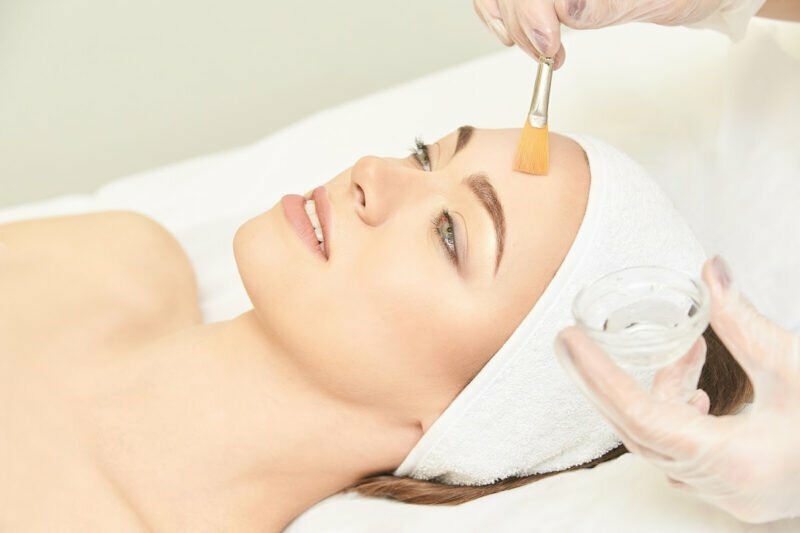
Improve Your Skin’s Healthy Glow with a Chemical Peel in Hagerstown, MD
Aging, sun exposure, and environmental damage leave their marks on our skin. A chemical peel can help give your skin’s surface a “clean slate” by removing the outermost layers of skin—and the visible damage along with it.
Chemical peels offer a non-invasive way to effectively address a range of issues—from signs of aging to texture irregularities—all with customizable options for different skin needs!
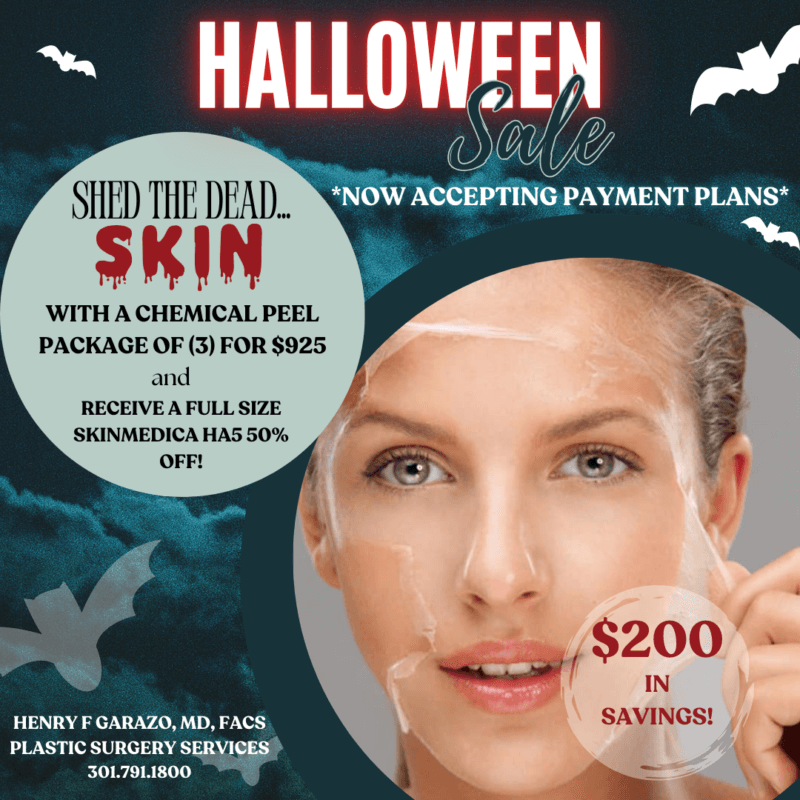
Shed the Dead Skin with a Chemical Peel!
This October, get a package of 3 chemical peels for $925
and receive a full size SkinMedica HA5 for 50% off!
How a Chemical Peel Works
Chemical peels use a specialized acid solution to remove the damaged outer layers of skin, thus reducing visible signs of aging, sun damage, and other flaws. While the peel itself is an in-office treatment, the peeling effects take place over several days following treatment, as your skin gradually heals itself (a process similar to peeling after a sunburn).
Peels can be light, medium, or deep, depending on the concentration and type of acid used. Light peels are excellent for brightening the skin and improving tone. Medium and deeper peels can be effective for treating more extensive signs of aging, such as wrinkles and brown spots, or can be used to help remove precancerous growths.
“My Diamond glow facial was the best experience. Shelby was nothing short of professional, kind, knowledgeable and helpful! I can’t wait to return! Do yourself a favor and go!”
—5-Star Google Review
Types of Chemical Peels
Light Chemical Peels
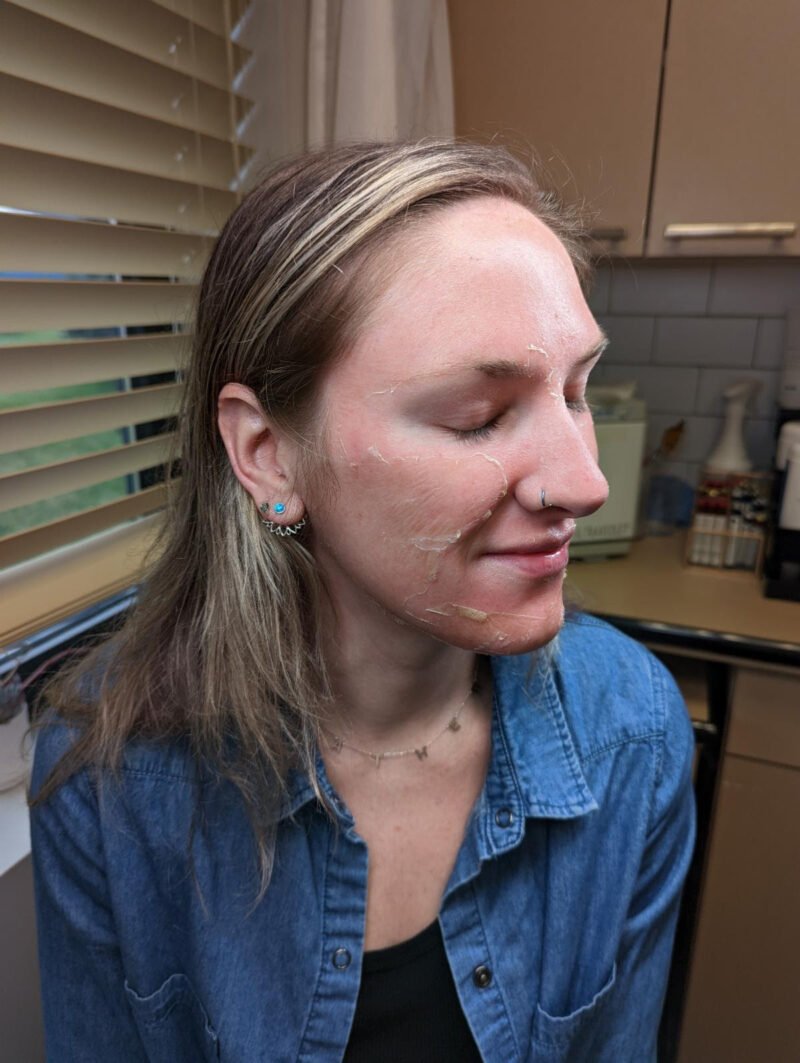
With convenient, comfortable treatment and very little downtime, light chemical peels are popular with patients who want to brighten, tone, and boost their healthy complexion. Common light peels include glycolic acid peels and TCA peels.
At our skincare services clinic, the VI Peel is our most popular light peel option. With unique formulations aimed at treating specific skin problems such as sun damage, acne-prone skin, and hyperpigmentation, VI Peels are safe for all skin types and provide a very comfortable peel experience.
Benefits of light VI Peels include:
- Little to no downtime
- Results apparent within 7 days
- Lasting results that can be enhanced with repeated treatments
Medium to Deep Chemical Peels
On occasion, patients have more extensive skin damage that requires a deeper peel. Medium and deep peels remove more layers of skin than light peels to achieve optimal results. Such peels typically require some downtime, and a local or topical anesthetic is usually given for patient comfort. However, the results can be well worth it for patients who wish to address moderate lines and wrinkles, severe acne scars, or precancerous lesions.
Pain-free chemical peels with PRO-NOX™
While many non-surgical and minimally invasive treatments are tolerable to most patients, we want to make sure your experience is as relaxed and comfortable as possible. That’s why we now offer PRO-NOX as an add-on option for your chemical peel.
What is PRO-NOX?
Have you ever heard of “laughing gas?” We typically think of the dentist when we hear nitrous oxide, but its ability to help ease discomfort and make you feel calmer can be a benefit in many situations—including your next cosmetic treatment at Plastic Surgery Services!
PRO-NOX is a self-administered nitrous oxide system that gives you control of your own comfort during treatment. Simply breathe through the mouthpiece when you need a bit of a relief, and the PRO-NOX system will deliver oxygen and nitrous oxide. You’ll feel it take effect in a matter of seconds—and when you’re done, it will wear off just as quickly. With no lasting effects, PRO-NOX is a great way to ease your pain and anxiety and then get back to your day.
Ask us about including PRO-NOX during your next appointment or contact us for more information!
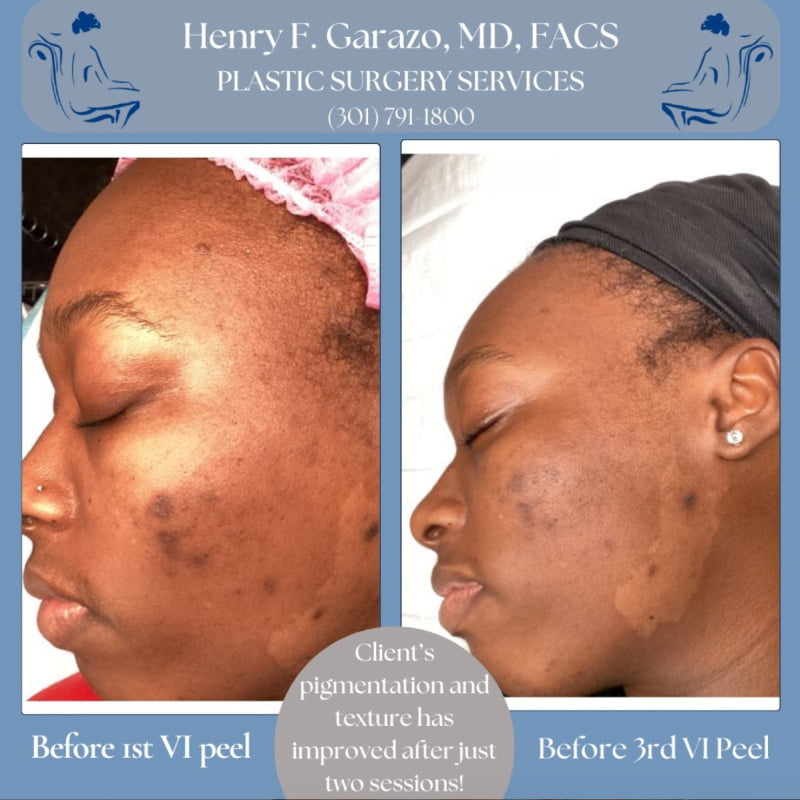
VI Peel®
We are happy to offer the VI Peel from VI Aesthetics at our skincare center here in Hagerstown. While some chemical peels can be uncomfortable, the VI Peel is uniquely formulated to provide painless treatment while still achieving noticeable improvements in skin texture and tone. A VI Peel is safe for any skin type and very little downtime is required. We may recommend a VI Peel if you wish to:
- Reduce fine lines and wrinkles
- Balance skin tone for a more even complexion
- Reduce rough or dry patches for smoother, softer skin
Many patients benefit from a supplemental at-home skincare regime using VI Peel System cleansers, moisturizers, anti-aging serums and/or sunscreen. Dr. Garazo will help you design a personalized treatment plan to help you experience optimal results from your VI Peel treatment.
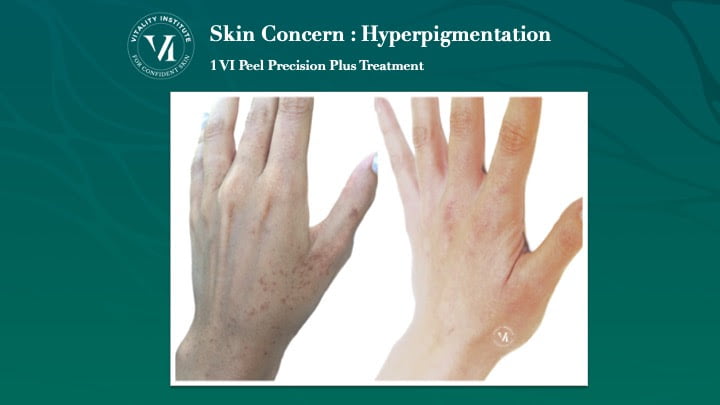
- Key Benefits
- Glossary
- Enhanced Skin Texture: Chemical peels remove the outermost layers of the skin, revealing smoother, softer skin underneath.
- Reduction of Fine Lines and Wrinkles: The exfoliating effect of chemical peels stimulates collagen production, which can reduce the appearance of fine lines and wrinkles.
- Improved Skin Tone and Clarity: By removing dead skin cells and stimulating new cell growth, chemical peels can even out skin tone and reduce the appearance of age spots, sun damage, and melasma.
- Acne and Scar Reduction: Certain types of chemical peels can penetrate deep into the skin to unclog pores, reduce the bacteria that cause acne, and diminish the appearance of acne scars.
- Minimized Pores: The exfoliating action of chemical peels can help to cleanse and minimize the appearance of enlarged pores, making them less noticeable.
- Increased Skin Hydration: Some chemical peels contain hydrating ingredients that leave the skin more moisturized and supple after treatment.
- Enhanced Absorption of Skincare Products: By removing the outer layer of dead skin cells, chemical peels enhance the skin’s ability to absorb and benefit from other skincare products.
- Quick and Convenient: Chemical peels can provide significant skin improvements in a relatively short amount of time, with some lighter peels requiring no downtime.
- AHA (Alpha Hydroxy Acid): A type of acid used in chemical peels, derived from natural substances such as sugar cane, milk, and grapes, that exfoliates the top layers of skin to improve texture and appearance.
- BHA (Beta Hydroxy Acid): A type of acid, such as salicylic acid, used in chemical peels that can penetrate deeply into the pores to remove dead skin cells and excess sebum, often recommended for oily and acne-prone skin.
- Chemical Peel: A skin-resurfacing procedure in which a chemical solution is applied to the skin to remove the top layers, stimulating new skin growth and improving the skin’s appearance.
- Dermabrasion: A skin-resurfacing technique that uses a rapidly rotating device to sand the outer layers of skin, often mentioned in the context of alternatives to chemical peels for skin rejuvenation.
- Exfoliation: The process of removing dead skin cells from the outer layer of the skin, which is a key component of the chemical peel treatment.
- Glycolic Acid: An alpha hydroxy acid (AHA) that is commonly used in chemical peels for its ability to penetrate the skin deeply and evenly, ideal for treating fine lines, acne, and uneven skin tone.
- Jessner’s Peel: A medium-depth chemical peel that combines lactic acid, salicylic acid, and resorcinol in an ethanol base, designed to reduce the appearance of fine lines, wrinkles, and hyperpigmentation.
- Lactic Acid: An alpha hydroxy acid used in chemical peels, derived from milk, that is gentle and hydrating, suitable for sensitive skin and first-time peel patients.
- Medium-Depth Peel: A type of chemical peel that penetrates the outer and middle layers of skin to remove damaged skin cells, addressing age spots, fine lines, and wrinkles.
- Peeling Agent: The chemical solution used in chemical peels, which can vary in type and strength, designed to improve the skin’s appearance by removing old skin.
- Phenol Peel: The deepest type of chemical peel, using phenol acid, effective for treating deep wrinkles, sun-damaged skin, and uneven skin tone, but with a longer recovery time.
- Post-Peel Care: The specific skincare regimen followed after a chemical peel, critical for healing and maximizing the benefits of the peel, including sun protection and gentle skincare products.
- Salicylic Acid: A beta hydroxy acid (BHA) commonly used in chemical peels for its ability to deeply cleanse pores and treat acne-prone skin.
- Superficial Peel: The mildest form of chemical peel, which only affects the outer layer of skin for gentle exfoliation, with minimal downtime.
- TCA Peel (Trichloroacetic Acid Peel): A type of chemical peel that uses trichloroacetic acid to medium or deeply penetrate the skin, effectively treating wrinkles, scars, and uneven skin tone.
- VI Peel: A brand of medium-depth chemical peel that combines several acids, including TCA, phenol, salicylic acid, and vitamin C, known for its effectiveness in improving skin tone, texture, and clarity with minimal downtime.
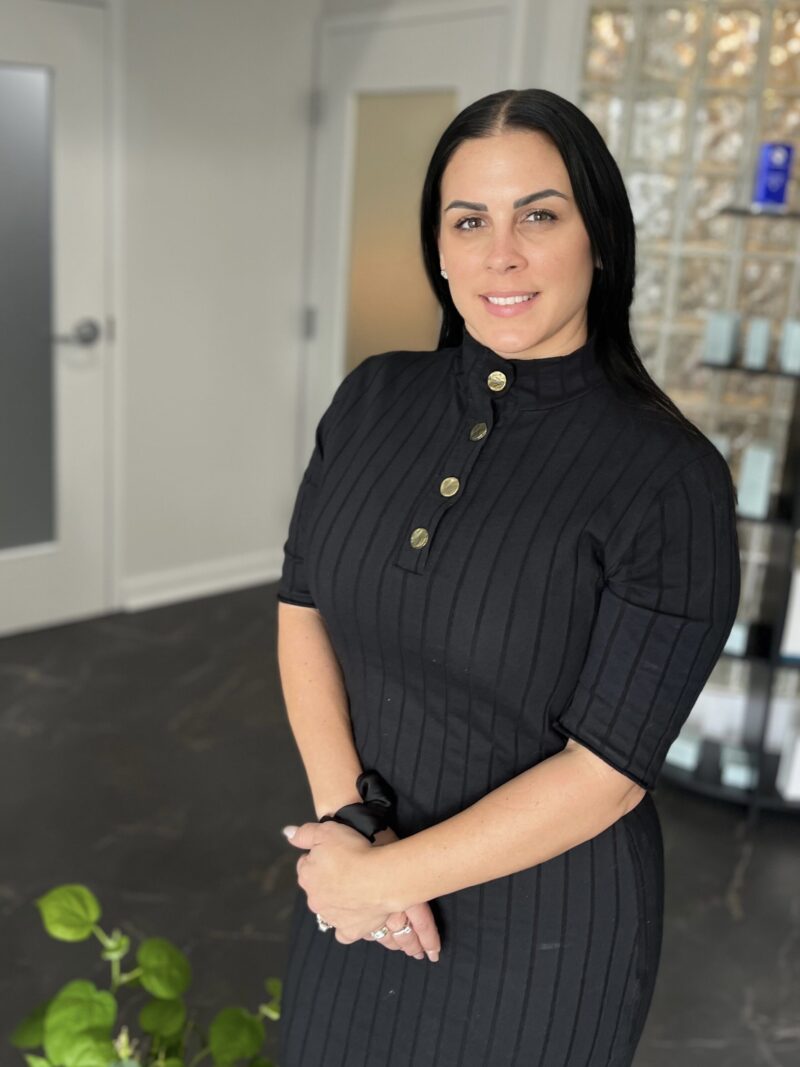
Our Licensed Aesthetician
Our Maryland medical aesthetician Shelby Mobley offers a full range of modern skin treatments at the Plastic Surgery Services Skin Care Clinic. With years of experience and an in-depth knowledge of medical-grade skincare products, her mission is to help you feel great about yourself by achieving the best results possible for your skin!
Explore Chemical Peel Options at a Personal Consultation
There are many types of facials and peels to meet your unique skincare needs. To learn more about your options, we encourage you to schedule a personal consultation with Dr. Garazo and our licensed aesthetician. She has years of experience in medical grade skincare, and has performed safe, effective peels for patients of all skin types, helping them enjoy beautiful results. Please call (301) 791-1800 or contact our office to set up an appointment.

Our VIP Membership is here!
We’ve got the PERFECT solution for maintaining your facial needs! Elevate your skincare routine with our VIP Membership and enjoy your favorite treatments at special prices. Memberships come in two tiers, so you can pick the plan that works for you, plus all VIP members get one free dermaplaning a month and save on skincare products.
References »
Rendon MI, Berson DS, Cohen JL, Roberts WE, Starker I, Wang B. Evidence and considerations in the application of chemical peels in skin disorders and aesthetic resurfacing. Journal of Clinic and Aesthetic Dermatology. 2010 Jul;3(7):32-43.
Sarkar R, Garg V, Bansal S, Sethi S, Gupta C. Comparative Evaluation of Efficacy and Tolerability of Glycolic Acid, Salicylic Mandelic Acid, and Phytic Acid Combination Peels in Melasma. Dermatologic Surgery. 2016 Mar;42(3):384-91. doi: 10.1097/DSS.0000000000000642.
Kontochristopoulos G, Platsidaki E. Chemical peels in active acne and acne scars. Clinics in Dermatology. 2017 Mar-Apr;35(2):179-182. doi: 10.1016/j.clindermatol.2016.10.011.
Chen X, Wang S, Yang M, Li L. Chemical peels for acne vulgaris: a systematic review of randomised controlled trials. BMJ Open. 2018 Apr 28;8(4):e019607. doi: 10.1136/bmjopen-2017-019607.
Bhardwaj V, Sharma K, Maksimovic S, Fan A, Adams-Woodford A, Mao J. Professional-Grade TCA-Lactic Acid Chemical Peel: Elucidating Mode of Action to Treat Photoaging and Hyperpigmentation. Frontiers in Medicine (Lausanne). 2021 Feb 12;8:617068. doi: 10.3389/fmed.2021.617068.


